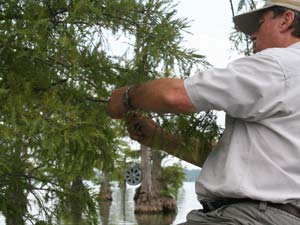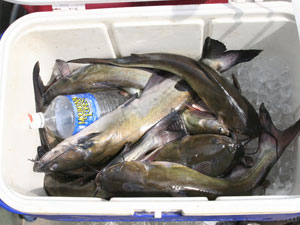
A rod and reel: Who needs them?
Sure, the hands-down majority of fish caught in North America are taken on some combination of fishing rods and reels (baitcasting, flycasting, spinning, etc.). Still, anglers have the option of fishing with a number of "no-tackle" methods that can be as productive as casting, jigging and bobbing. These methods utilize limbs, rocks, jugs, soda cans, nylon line, stout hooks and other simple components. Techniques for utilizing them are easy, inexpensive and highly efficient at catching catfish and other popular species.
 |
| Yo-yo fishing is a great alternative method for catching catfish, bream and other species. (Check local regulations to make sure yo-yo fishing is allowed in your area.) |
Following are descriptions of six alternative fishing methods that anglers might try. Before doing so, however, they should check local regulations to see what is allowed and what isn't. Fishing laws vary widely from state to state; it's better to be safe than sorry.
1. Limb-Lining Fishing Method
Limb-lining is the simplest of all alternative fishing methods. Tie a length of strong line to a limb hanging over water where fish are likely to feed. Adjust the line's length to extend 2-3 feet into the water. Tie a strong fishing hook (1/0 to 3/0) on the opposite end of the line, and add enough weight 6 to 8 inches above the hook so the line will hang vertically beneath the limb. Then bait the hook with a nightcrawler, live minnow, fish chunk, or some other choice catfish morsel. Bait up in late afternoon, and then check the line the next morning. Chances are you'll find a feisty channel or blue cat struggling to get away.
Limb-lining is a numbers game. Most limb-liners set at least two dozen lines at a time, spreading them along a river bank or lakeshore. Rig lines in different areas — in deep pools, below riffles, along rocky banks, near log jams. This way you can learn where the fish are feeding best and concentrate your lines there the next night.
Tie lines to limbs that are alive and springy. This way, when a big catfish takes the bait, the limb will bend but not break when the fish tries to get away.
![]() One other note: be sure to remove your limb-lines when you're through fishing. This is required in most states, and it's common courtesy not to litter the stream bank or lakeside with abandoned lines that can be dangerous to both humans and wildlife.
One other note: be sure to remove your limb-lines when you're through fishing. This is required in most states, and it's common courtesy not to litter the stream bank or lakeside with abandoned lines that can be dangerous to both humans and wildlife.
2. The Yo-Yo Fishing Method
"Yo-yoing" is a high-tech method of limb-lining.
A yo-yo is an automatic reel consisting of a stainless steel spring encased in a sheet metal disc (about the diameter of a doughnut). This device has a line attached to its topside for tying to a springy green limb, suspending the yo-yo above the water's surface.
Inside the yo-yo are several feet of strong nylon line wrapped around the spring. The end of this line dangles from the bottom of the yo-yo. A snap swivel is tied onto the end. A stout 1/0 to 3/0 hook (attached to the line via the snap swivel) and one or two split shot complete this rig.
After the yo-yo is tied to the limb, the fish hook is baited, then enough line is pulled off the reel to lower the hook/bait 2 to 3 feet beneath the surface. As the line is pulled off the reel, the spring coils tighter. When the desired length is reached, a small wire trigger on the side of the reel is set to hold the line at that depth. Then, when a fish takes the bait, it trips the trigger, and the reel uncoils quickly to set the hook. Then the reel holds constant pressure on the fish, giving line as it pulls, and taking up slack as the fish tires.
As with limb lines, the best strategy is to scatter two dozen or more yo-yos along a tree or brush-lined river or lakeshore. Set them at dusk, and then run them periodically through the night or at first light in the morning.
Also, yo-yos can be rigged with monofilament leaders and smaller hooks to catch bluegill and crappie. For these fish, set the yo-yos around boat docks and brushpiles, and bait with wigglers and small live minnows respectively.
3. The Jug-Fishing Method
Plastic two-liter pop bottles (with caps on), nylon line, hooks, sinkers and bait are the ingredients necessary for jug-fishing. Lines are cut to 4 to 10 foot lengths, depending on water depth. (Six-foot lengths are a good average.) Then, each piece of line is tied snugly around a pop bottle's neck. A 2/0 bait keeper hook is tied to the opposite end of the line, and enough split shot is added a few inches above the hook so the line hangs vertically beneath the jug. Then the line is wrapped around the jug and held snugly with a heavy rubber band for storage purposes. (Commercial catfish jugs are also available.)
 |
| Standard rod-and-reel fishing methods produce bountiful catches, but so do such alternative methods as limb-lining, jug-fishing, yo-yo fishing and others. |
Jug-fishermen use a boat and motor to set out 20 or more jugs at a time. Jugs are unwrapped, baited and dropped in the water on the upwind/upcurrent side of a flat, channel, pool, etc. Then the wind or current drifts the jugs through these feeding areas. The angler floats alongside his jugs, watching for one to tip up and move off as a hooked catfish tries to escape. When the bite is good, the angler will stay busy chasing down jugs, retrieving fish and rebaiting lines.
Best results at jug-fishing usually come during low-light periods of dawn and dusk. Also, jugs can be run at night by painting them with orange or phosphorescent paint and checking them with a spotlight.
![]() Be sure to check local rules pertaining to jug-fishing, specifically about how many jugs may be used and how they must be marked for identification.
Be sure to check local rules pertaining to jug-fishing, specifically about how many jugs may be used and how they must be marked for identification.
4. The Trotlining Fishing Method
Trotlining is an extremely efficient means of "alternative fishing" that is a favorite of commercial fishermen.
Trotlines are long lengths of strong nylon line with "droppers" and hooks spaced evenly along a "mother line." The line is secured on one end by tying or weighting. The hooks are baited, and the line is stretched taut and secured on the other end. The typical sportfishing trotline has 25 hooks. Lines are usually set in the afternoon and run the next morning.
Trotline kits are sold in most tackle stores and mail order houses. Instructions in the kits show how to rig and deploy the lines. One common method is to tie one end of the line to a stationary object on the shoreline (tree, rock), stretch the line into the river or lake, then anchor the other end with a heavy weight. Also, small "dropper weights" should be added every 5 to 6 hooks to hold the baits on or close to bottom. These weights (around a pound each) should be attached to the mother line with dropper lines around a foot long.
Typical trotline baits are goldfish, cut fish parts, grasshoppers, etc.
5. The Setting Poles Fishing Method
This is a specialty rig for catching big flathead catfish from smaller rivers and streams.
Use a hatchet to chop out sturdy hardwood saplings 7 to 10 feet long. The poles should have a fork on the end. Drive these poles into the bank of the river at the heads of deep pools, preferably where the bottom is sloping from shallow to deep. When set properly, the forked end of the pole will angle out over the water 3 to 5 feet, and the butt will be lodged securely in the muddy bank.
Next, tie a long length of heavy tarred nylon fishing line to the closest limb or sapling back up the bank. Unroll the line to the end of the pole, and wrap it several times just below the fork. Then run enough line out so the hook and bait will hang within a foot of the river bottom. Add a 4/0 to 6/0 hook, and loop a bell sinker onto the line a foot above the hook. Use enough weight to hold the line vertically in the current.
Last, bait this hook with big goldfish or small bluegill (where legal). Hook the bait through the back just behind the dorsal fin so it can swim naturally. Rig several set poles in this manner during the day, then bait and run them at night. This fishing method will take the biggest flathead cats in the river.
6. The Soda Can Fishing Method
Don't have funds for a new fishing reel? No worry. Try casting with an aluminum soda can. Using cans for casting lines has been practiced for years in the Orient and Latin America. This fishing method works amazingly well with a little practice.
The concept is the same as using a spinning reel. The can serves as the reel spool. Tie monofilament line around the can, then wrap on several feet — enough to make a cast. Add hook, sinker and bait on the other end.
To cast, hold the can at one end so the opposite end is unencumbered. Catch the dangling end of the line in your index finger, cock your arm, and sling as you release the line. Done properly, the line will coil off freely, and the weight of the terminal tackle will provide the inertia to gain distance.
This is not a method for continuous casting/retrieving. Instead, it is a means for slinging a line for stationary fishing when a rod/reel isn't available. When a fish takes the bait or you want to make another cast, pull the line by hand, wrapping it back onto the can as it comes in.
- 30048 views

